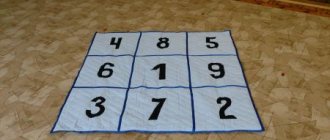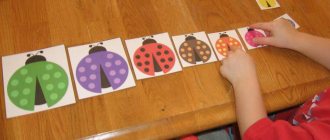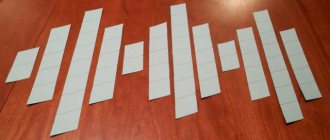Pedagogical Council "USE OF MODERN FORMS OF ORGANIZATION OF WORK ON FEM, TAKEN INTO ACCOUNT OF GEF"
Preschool age is characterized by its own characteristics. The formation of children's knowledge occurs in close connection with their practical actions.
An analysis of the conditions in a preschool institution (educational qualifications of teachers, material and technical conditions: the presence of a mathematics classroom and a computer lab, etc.) and the results of monitoring the development of children (15-18% of preschoolers have a high level of development of elementary mathematical concepts) showed that the time is ripe the need to work on increasing the level of development of elementary mathematical concepts in preschoolers and finding ways to effectively teach in this section.
Kindergarten is the first and very important stage of the general education system. Preschool teachers and scientists currently face a common task - to improve all educational work and improve the preparation of children for school.
An important place should be given to teaching preschoolers the basics of mathematics. This is caused by a number of reasons: the beginning of schooling at the age of six, the abundance of information received by the child, increased attention to computerization, the desire to make the learning process more intensive, and the desire of parents in this regard to teach the child to recognize numbers, count, and solve problems as early as possible. The main goal is being pursued: to raise children as people who can think, navigate well in everything that surrounds them, correctly assess the various situations they encounter in life, and make independent decisions.
Teaching children mathematics in preschool age contributes to the formation and improvement of intellectual abilities: logic of thought, reasoning and action, flexibility of the thought process, ingenuity and ingenuity, and the development of creative thinking. The human brain requires constant training and exercise. As a result of exercise, a person’s mind becomes sharper, and he himself becomes more resourceful and quick-witted.
2. Report “Intellectual games as a means of developing elementary mathematical concepts”
3. Message from work experience “My system of working with parents of students in FEMP”
4. Business game “Mathematics is interesting” (senior teacher)
1. Presentation of a mathematical corner in a group.
2. Master class demonstrating a specific methodological technique for FEMP.
3. “Kaleidoscope of fine arts” drawing up a mathematical puzzle
4. Compiling a puzzle on the topic “Numbers” and “Geometric Shapes”.
Let's consider the techniques used in educational activities on FEMP
3.4. Forms of work on pre-mathematical development of children
3..4. Forms of work on pre-mathematical development of preschool children.
- Forms of work on pre-mathematical development of preschool children.
- Types and types of occupations, their features, structure
- Forms of work outside of class
- Forms of work on pre-mathematical development of preschool children.
In didactics, “form” (device, structure, system of organization, internal structure) is considered as a way of constructing educational activities. Organizational forms of education must reliably ensure the implementation of the objectives of the educational process, the ultimate goal of which is to promote the comprehensive and, first of all, intellectual development of children.
Variety of training forms
is determined by the number of students, the place and time of classes, the methods of children’s activities, as well as the methods of managing this activity by the teacher.
Based on the characteristics of the organization of training, determined by the number of students, there are individual, collective and group (differentiated) forms of training.
.
Individual training
– lies in the fact that the child receives new ideas, performs different tasks, and has the opportunity to receive direct help from an adult.
Collective learning
– involves the work of a teacher with a group of children. There is mutual assistance and mutual learning. The disadvantage is that individual differences are not sufficiently taken into account.
Differentiated learning
in pedagogical practice it is called “group”, “individual-group”, or “collective-group” learning.
Differentiated training is carried out according to the following criteria:
- by ability or inability to learn;
- by interest;
- by volume of material and degree of complexity;
- by the degree of independence and pace of progress in learning.
In the 40s of the 20th century, Leushina A.M. first proposed classes as a form of teaching mathematics in kindergarten
. Metlina L.S. in the 80s she developed notes for mathematics lessons for all age groups of preschool children. Until the 90s, it was believed that the main form of teaching mathematics to preschoolers was the classroom. To teach children mathematics, classes were held once a week.
However, it must be taken into account that those mathematical concepts that are formed in preschool age are of an applied nature for children. Children need mathematical concepts for daily orientation in the world around them. Therefore, they should be formed in a variety of activities (communication, play, cognitive-practical, artistic, labor).
- Types and types of occupations, their features, structure.
At the present stage of development of the preschool education system, state documents (Code on Education of the Republic of Belarus, Standards of Preschool Education, Model Curriculum for Preschool Education) determine the status of the game, classes
as
the main form
of a specially organized educational process.
The number of classes in
the educational field
“
Elementary mathematical concepts
” and the time allotted for their implementation are regulated by the Standard Preschool Education Curriculum.
- first junior group – once every 2 weeks (10 min.)
- second junior group – 1 time per week (15 min.)
- middle group – 1 time per week (20 min.)
- senior group 5-6 years old – once a week (25 min.)
- senior group 6-7 years old – once a week (30 min.)
Classes in the educational area “Elementary Mathematical Concepts” are held mid-week in the morning in combination with classes that do not require a high mental load (physical education, music classes or visual arts classes).
During the holidays, these classes are not conducted; the concepts and skills acquired by children are consolidated in everyday life: in games, play exercises, on walks, etc.
In all age groups, classes are conducted frontally, i.e. simultaneously with all children. Only in the first junior group is it recommended to conduct classes in subgroups (6-8 people), including all children, in order to gradually teach them to study together.
Requirements for conducting classes
in the educational field “Elementary mathematical concepts”
- are built taking into account general didactic principles: scientific character, systematicity and consistency, accessibility, clarity, connection with life, individual approach to children, etc.;
- implement all the contents of the educational field “Elementary mathematical concepts”;
- the implementation of educational, educational and developmental tasks in the classroom occurs in a comprehensive manner;
- the content of each specific lesson, the formulation of its tasks, is carried out on the basis of the content of the educational field “Elementary mathematical concepts”, taking into account the characteristics of children and their level of development;
- each lesson occupies its own, strictly defined place in the system of lessons for the study of a specific program task in the educational field “Elementary mathematical concepts”;
- The program objectives of the lesson determine its structure. In the structure of the lesson, separate parts are distinguished: from one to four or five, depending on the number, volume, nature of the tasks and the age of the children. All parts of the lesson are independent, varied and related to one another;
- in one lesson one new problem is solved, the rest are for repetition and consolidation;
- new material is given in the first part of the lesson, as it is mastered, it moves to other parts; subsequent parts of the lesson are usually conducted in the form of a didactic game, in which children’s ideas and skills are consolidated and applied in new conditions;
- widespread use of didactic games and exercises with handouts;
- organization of physical education (after the first or second part).
Since the leading activity in preschool age is play, play methods and techniques of interaction between teacher and student are predominant in the lesson, i.e. classes can be of a playful nature or presented as play-based didactic complexes.
In accordance with the didactic objectives, the type of lesson is determined:
- Training type
(learning new ideas).
Goal:
setting cognitive tasks for children, presenting, expanding and clarifying children’s ideas about quantity, size, geometric figures and the shape of objects, space and time;
- Fastening type
(consolidation and systematization of children’s accumulated experience).
Goal:
understanding the perceived ideas and forming primary generalizations.
- Combined (mixed) type
classes.
Goal:
learning new content and repetition, consolidation and systematization
Types of activities
in the educational field "Elementary mathematical concepts"
Combined lesson
can be integrated - by selecting objects of knowledge from different educational fields or components of one educational field; can be playful or non-playful - according to the predominance of methods of educational interaction, according to the nature of the interaction between students and the teacher, and between students.
Its structure:
- Organizing time.
- Implementation of the learning task. Mastering new material.
- Consolidating newly acquired ideas in children’s independent activities.
- Movable pause.
- Implementation of educational content from other components of the educational field.
- Bottom line.
Complex lesson
involves a combination of classes in the educational area “Elementary mathematical concepts” with classes in other educational areas. In this case, in the lesson on the formation of elementary mathematical concepts (it is the first part of a complex lesson), learning tasks are implemented, children master new educational content, and in classes in other educational areas - the use, consolidation, expansion, clarification, deepening of the newly mastered educational content takes place. content. The structure of a complex lesson is flexible and variable. It should be remembered that the greatest pedagogical effect can be achieved by combining classes in the educational area “Elementary mathematical concepts” with classes in the educational area “Art”, “Child and Society”, “Child and Nature”.
Game complexes with mathematical content
(as a game version of a combined lesson):
- didactic in nature.
A didactic game is selected to solve each program problem, and children play it either in a sequence determined by the plot of the lesson, or in a random sequence determined by the “magic arrow”, spinning top, child’s choice, etc.;
2) educational and developmental in nature.
Complex diagram:
- a game or gaming exercise to develop attention, perception, sensation, and activate memory;
- a game or game task for the development of reproductive thinking, the formation of certain mathematical concepts (training);
- a game or play exercise that helps develop independent reproductive thinking and consolidate acquired ideas in independent practical activities;
- an outdoor game or exercise aimed at increasing motor activity, consolidating mathematical concepts, and developing cognitive processes;
- a game or play exercise for the development of divergent thinking (creative, productive), imagination, logical thinking, the formation in children of the ability to use their ideas in new conditions, the development of elements of logical thinking;
- a game or play exercise for relaxation and imagination development.
Lesson using educational visual aids
(
with individual notebooks).
Structure:
- Didactic game or game exercise.
- Work with educational visual aids (formation of new ideas, expansion and deepening of the mastered material).
- An outdoor game, or a relay game, or a physical education break.
- Working with educational visual aids (completing graphic tasks, actions with cut material).
- Didactic game or game exercise.
Classes using computers.
In some preschool institutions there are computer and gaming complexes (one room is a computer class, the second is a room for mental and physical relaxation).
Advantage
this form: the possibility of an individual approach to learning, the computer is an interesting toy for the child - children develop attention and interest in learning, etc.
If you violate the rules for using a computer, your work can have a negative effect.
A child 4-6 years old can be at the computer for no more than 10 minutes, 1-2 times a week (otherwise the child’s posture, vision, and psyche will be impaired). Therefore, with the help of a computer it is necessary to solve only those software problems that are solved less effectively in other forms.
- Forms of work outside of class
(unregulated activity)
Individual work
with the child allows for pedagogical correction. The forms of this work are exercises, work with individual material (notebooks, didactic material), etc.
Game with mathematical content.
It is planned at least 2-3 times a week individually, in a group (or part of it).
All types of games can be planned. Didactic games.
There are many collections with d/i on mathematics by such authors as Sai, Udaltsova, Mironova, Starzhinskaya, Novikova.
Plot-didactic games
(this term was proposed by A. Smolentsova, “Plot-didactic games with mathematical content,” 1985)
Educational games
. Proposed by Z.A. Mikhailova, B.P. Nikitin (“Steps of creativity or educational games”).
On the day of the lesson in the educational area “Elementary mathematical concepts”, a game with mathematical content is not planned.
Examination.
It is planned at least 2 times a week individually, in a group (or part of it) when developing the ability to group objects; establishing a one-to-one correspondence in a practical way; bills by touch; dividing a whole into parts; comparing quantities and ordering; examination of geometric figures and determination of the shape of an object; orientation from oneself, in the surrounding environment.
Experiences, experiments.
Planned as needed, but no more than once a week individually, in a group (or part of it) while developing an understanding of the independence of number from qualitative and spatial characteristics; understanding the dependence of the result of ordinal counting on the direction of counting and the independence of the result of quantitative counting on the direction of counting; skills of transfiguration and transformation.
Observations.
Planned daily individually, in a group while forming ideas about the parts of the day and their sequence; ideas about the seasons and their sequence.
Story, conversation.
Planned as necessary individually, in a group when forming temporary ideas; ideas about geometric figures and the shape of objects; ideas about size, about ordering by size.
Entertainment with mathematical content.
It is planned no more than 1 time per quarter by group. It can be planned as a competition, theatrical or circus performance, folklore festival, travel, etc. It can replace a complex lesson or game complex. On this day, a lesson in the educational area “Elementary Mathematical Concepts” is not planned.
Viewing works of fine art.
It is planned as needed, but at least once a month by the group (or part of it) when forming quantitative, spatial and temporal ideas; ideas about size and space. Artistic illustrations, photographs, reproductions of paintings, paintings (still lifes, everyday life, animalistic, mythological genres) are used.
Reading literary works with mathematical content.
It is planned as needed, but at least once a month by the group (or part of it). When reading, mathematical characteristics, mathematical actions (their necessity, sequence, correctness, adequacy of the situation, etc.) that are performed by the heroes of the works are highlighted.
Independent cognitive activity
:
- games with didactic material,
- role-playing games,
- situations of work and everyday activities.
- working with a book (coloring, cutting out, comparing by size): books like coloring books, books like math notebooks - “Geometry for Kids”, etc.,
- performing entertaining exercises (puzzles, games with sticks)
Signs of independent cognitive activity are:
children's interest in it; manifestation of creative initiative; independence in choosing a game and how to implement the plan.
In independent cognitive activity, children’s ideas about numbers, sizes, geometric shapes, time, and space are clarified, deepened and expanded.
Each of the listed forms is planned in different types of activities with a certain frequency and has specifics in the way children are organized, depending on the age group and the content of the problem being solved.
LITERATURE
- Zhitko, I.V. Formation of elementary mathematical concepts in children from 4 to 5 years old: educational method. A manual for preschool teachers. education. Minsk: Ecoperspective, 2021. – 200 p.
- Formation of elementary mathematical concepts in preschoolers / ed. A.A.Stolyar. – M., Education 1988
- Shcherbakova, E.I. Methods of teaching mathematics in kindergarten: a textbook for preschool students. department and faculty avg. ped. textbook establishments. M., Ed. , 1998 – 272s
6




